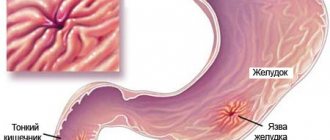Vomiting blood after alcohol
If you vomit blood after drinking alcohol, this in itself is an alarming symptom, and inclusions of blood in the vomit signal the development of internal bleeding. Its intensity is determined by doctors as part of the diagnosis.
Bleeding of 200-400 ml is usually asymptomatic. However, mild symptoms may appear:
- mild nausea;
- chills;
- dry mouth;
- weakness.
Heavy bleeding can be detected independently by the following symptoms:
- general malaise;
- pain;
- noise in ears;
- cardiopalmus;
- high blood pressure;
- dizziness.
Characteristic changes occur in the patient's appearance: the skin becomes pale and moist due to increased sweating. Also, due to strong thirst, his voice becomes hoarse. If bleeding begins in the gastrointestinal tract, its characteristic sign is semi-liquid black stool with a pungent odor.
Intense blood loss cannot be stopped on your own. In this case, it is necessary to take the person to the hospital, where specialists will take the necessary measures. Otherwise, the patient will develop shock, which can lead to death.
Bleeding is usually preceded by severe pain, but then it decreases or disappears completely. The fact is that the secreted blood is neutralized by hydrochloric acid in the vomit. The danger is high blood pressure, which can cause loss of consciousness.
Symptoms of alcohol intoxication in the body
When poisoned by alcoholic beverages, a disruption in the functioning of organs occurs, which manifests itself in the form of characteristic symptoms. And this happens due to the influence of alcohol and its breakdown products.
The main impact falls on the central nervous system. In this case, the following symptoms of alcohol poisoning will be observed:
- When poisoned by alcoholic beverages, organ dysfunction occurs, which manifests itself in the form of characteristic symptoms.
panic attacks (display of unreasonable fear for one’s life);
- rave;
- state of euphoria;
- irritability;
- apathy;
- hallucinations;
- convulsions;
- decreased body temperature;
- impaired coordination and perception;
- speech defects.
Such symptoms of alcohol poisoning appear due to the effects of ethanol on nerve tissue. As a result, oxygen starvation and metabolic disorders occur. In rare cases, brain damage may occur due to alcohol intoxication. Treatment of the pathology can be difficult.
The cardiovascular system also suffers from intoxication. In this case, the following symptoms of alcohol poisoning may be observed:
- arrhythmia or tachycardia;
- a sharp drop or increase in pressure;
- dizziness;
- pallor or severe redness of the face and skin;
- malaise.
These signs may appear due to the development of dehydration. When there is a lack of fluid in the cells, the body “borrows” it from the blood. As a consequence, a decrease in its volume. To make up for the deficiency, the body is forced to constrict peripheral vessels, supplying blood to more important organs.
In severe cases, alcohol poisoning can cause a heart attack or stroke.
Against the background of alcohol intoxication, the respiratory system can also suffer. In this case, the following are observed:
- lack of air;
- rapid and noisy breathing.
The manifestation of such symptoms is due to damage to the respiratory center, the formation of cerebral edema, and metabolic disorders.
Vomiting blood after drinking alcohol should also be a concern. This is a very dangerous symptom associated with the development of bleeding in the esophagus and requires immediate medical attention.
If a patient vomits blood after drinking alcohol, the reasons may be:
- a crack or tear in the esophagus or stomach;
- open bleeding in the throat or esophagus;
- cirrhosis of the liver.
If vomiting occurs after drinking alcohol, the reason may lie in the development of gastritis in an acute form.
If vomiting occurs after drinking alcohol, the reason may lie in the development of gastritis in an acute form. To make an accurate diagnosis and establish the source of the manifestation of such a symptom, you must consult a doctor.
The most dangerous symptom for health, and even for the life of the poisoned person, is black vomit. Its occurrence indicates that severe bleeding has opened in one of the organs.
Do not stop vomiting blood or bile by taking antiemetics or rinsing. Self-medication in this case can lead to irreversible consequences.
If the patient has received severe alcohol poisoning, the symptoms may be as follows:
- no reaction to tingling or popping;
- the skin takes on a bluish tint;
- body temperature drops sharply;
- breathing is practically not audible.
If such symptoms are observed, the patient requires urgent medical intervention.
Causes
Most often, if you vomit blood after drinking alcohol, this indicates the presence of mechanical damage to the walls of the stomach or esophagus. A number of reasons lead to this, but they can only be determined through diagnostics in a medical institution.
Mallory-Weiss syndrome
Blood in the vomit after alcohol abuse can cause Mallory-Weiss syndrome. It consists of a violation of the integrity of the gastric mucosa, which occurs as a result of a significant increase in pressure in the upper part of the gastrointestinal tract.
After abusing alcohol, an attack of vomiting often occurs, especially since the feast is always accompanied by a large meal. The pressure in the gastrointestinal tract increases even more. As a result, minor damage to the mucous membrane intensifies, tears and cracks form.
To treat Mallory-Weiss syndrome, doctors try to use conservative methods. However, sometimes complications are diagnosed that require surgery.
In the video, the stomach of a patient with Mallory-Weiss syndrome:
Internal varicose veins
If blood clots in the vomit after drinking alcohol are scarlet in color, there is a high probability that the stomach walls are damaged as a result of internal varicose veins. With this disease, the vessels of the mucous membrane cannot withstand the pressure due to the accelerated movement of blood through them and burst. Scarlet bleeding caused by internal varicose veins usually does not last long.
The dark color of blood clots in vomit poses a great danger. In such a situation, it is impossible to predict the duration of blood loss and its intensity, so urgent measures must be taken. The patient needs emergency medical care.
Stomach ulcer and cirrhosis
A common cause of blood clots in vomit after drinking alcohol is a stomach ulcer. The disease develops as a result of prolonged abuse of alcoholic beverages.
Ethyl alcohol changes the composition of gastric juice, increasing the content of hydrochloric acid in it. Any meal causes pain in the upper abdomen, but after eating the pain decreases. In this regard, appetite gradually disappears, a feeling of heaviness in the stomach, nausea, and heartburn appears.
With a peptic ulcer, drinking alcohol causes an exacerbation, which provokes the destruction of large vessels. And this may also be the answer to the question of why people vomit blood after drinking alcohol.
In this case, profuse bleeding develops, often leading to perforation of the ulcer. It is expressed in the fact that the contents of the stomach fall into the abdominal cavity, after which peritonitis forms.
If the patient suffers from cirrhosis, drinking alcohol in his case may also be accompanied by vomiting mixed with blood. A serious complication of this disease is varicose veins of the esophagus.
Since the functionality of the liver deteriorates in cirrhosis, the free circulation of blood in the organ becomes more difficult, and the pressure in the veins increases. Because of this, damage to the vascular walls occurs, and the vessels themselves begin to burst and bleed.
If a person has cirrhosis of the liver, alcohol is strictly contraindicated for him. In this case, a person requires regular monitoring of the functioning of the organ. This is the only way to prevent serious complications.
Other reasons
There is also an extensive list of pathologies that provoke bloody vomiting after drinking alcohol. These include:
- Oncology of the stomach and esophagus.
- Foreign bodies in the stomach and esophagus.
- Inflammation of the esophagus.
- Surgical diseases of the gastrointestinal tract.
- Chronic diseases.
Surgical diseases that lead to the appearance of blood in post-alcohol vomit include intestinal obstruction, appendicitis, cholecystitis, pancreatitis, peritonitis, and various internal bleeding. Pancreatitis, duodenitis, kidney stones and other chronic diseases also lead to this pathology.
Features of the rehabilitation period
If the condition has improved, this is not at all a reason to continue drinking alcohol. To achieve a complete recovery and prevent a possible situation in the future, you must adhere to some rules of the rehabilitation period:
- Completely eliminate the intake of alcoholic beverages during the treatment period.
- Drink enough water without gas, sugars and dyes.
- Eat small meals, excluding fatty, smoked, fried, pickled and spicy foods from your diet. Such products can irritate the gastric mucosa, which will increase unpleasant symptoms.
- Outdoor walks are shown. Moderate physical activity stimulates the digestive tract.
Self-medication is fraught with the development of a number of complications, so if vomiting blood occurs, you should not refuse treatment in a hospital.
Mode
In the first days of treatment, the patient is given complete rest and bed rest. On days 3-5, you can get out of bed and perform simple exercises to warm up all parts of the body. Drinking alcohol is strictly prohibited. If there is an addiction, the treatment plan includes medications that help cope with alcoholism.
Diet
For the next month, the patient is prescribed a strict diet consisting of the following dishes:
- Mashed porridge in water with a little added salt - porridge envelops the walls of the stomach, forming a protective film.
- Kiseli - a high-starch drink satisfies hunger well without irritating the stomach.
- Puree vegetable soups – saturate the body with carbohydrates and nutrients.
After the patient’s condition rapidly improves, boiled chicken eggs and boiled lean meat, steamed fish, and fermented milk products are introduced into the diet.
You will have to give up eating canned food, fast food, smoked and fried foods. These products require the production of additional gastric juice, which can lead to irritation of the mucous membrane.
First aid
If bloody vomiting occurs after drinking alcohol, you cannot wait until the condition normalizes on its own. First of all, the person must be placed on the bed, with a pillow under his head, and also covered with a blanket. When your legs and arms are warm, blood circulation will improve in them.
In order to prevent blood stagnation, a person needs to be turned over from time to time. It is important that someone is always present with the patient, because he may lose consciousness or choke on vomit.
You need to place a basin next to the bed, because the urge to vomit may continue. The patient needs to be provided with plenty of fluids and also given 6-8 tablets of activated carbon. These measures will help remove toxins and waste from the body.
Eating food during bouts of hematemesis is something you should not do if you are feeling sick or vomiting blood. Any food will only aggravate the patient's condition. It is also important to monitor your blood pressure and pulse.
These are emergency measures that will help alleviate the patient’s condition a little and prevent serious complications. If pain and fever are added to the symptoms, you must call an ambulance or take the person to the hospital yourself.
Why do people abuse alcohol and become drunkards?
Alcoholism is a complex disease that is treated by psychiatrists and narcologists. It is fatal and incurable: when a certain concentration of ethanol in the blood is reached, a person is “hooked” and will strive to achieve a state of intoxication for the rest of his life. No health problems that would shock an ordinary person can stop an alcoholic.
It is very important for the patient to understand in time that alcohol dependence exists. If you solve it, then problems with nausea, vomiting, nervousness and other “charms” of alcoholism will disappear by themselves. The patient himself must realize the severity of health problems and their consequences in order to stop drinking.
Treatment
To identify the causes of blood clots in vomit, in a hospital setting, specialists will conduct tests, x-rays and gastroscopy. Once an accurate diagnosis has been determined, appropriate treatment will be prescribed. Usually it is possible to manage with conservative methods, but sometimes surgical intervention may be required.
Treatment for bloody vomiting after alcohol includes the following measures:
- gastric intubation;
- taking medications to stop bleeding;
- removal of excess blood from the gastrointestinal tract.
To remove blood clots, the stomach is washed with cool water (about +4 degrees). To control the intensity of bleeding, probing and aspiration are periodically performed.
If the diagnosis reveals indications for surgical intervention, the patient is given special medications to stop the bleeding and prevent its recurrence.








